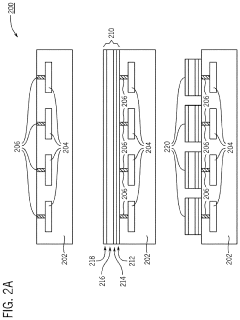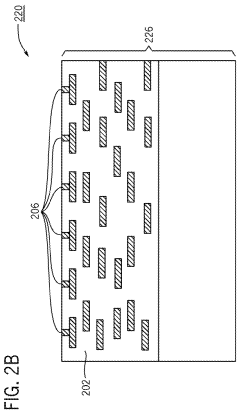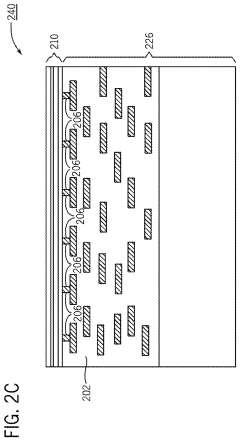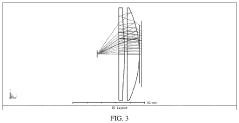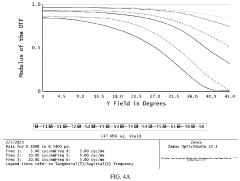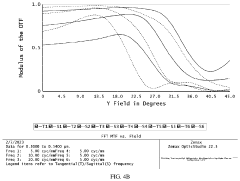QNED: Overcoming Display Brightness Challenges
JUN 19, 20259 MIN READ
Generate Your Research Report Instantly with AI Agent
Patsnap Eureka helps you evaluate technical feasibility & market potential.
QNED Technology Evolution
QNED (Quantum Nano Emitting Diode) technology has undergone significant evolution since its inception, marking a series of breakthroughs in display technology. The journey began with the development of traditional LED and QLED displays, which laid the foundation for QNED's emergence.
In the early stages, researchers focused on enhancing the quantum dot technology used in QLED displays. This led to the creation of nanorod structures that improved electron transport and light emission efficiency. The integration of these nanorods with quantum dots marked the birth of QNED technology.
A crucial milestone in QNED evolution was the development of precise control over nanorod growth and alignment. This advancement allowed for better color purity and increased brightness, addressing one of the primary challenges in display technology.
The next phase saw the optimization of the quantum well structure within the nanorods. By fine-tuning the composition and thickness of the quantum wells, researchers achieved higher electron confinement and improved radiative recombination rates. This resulted in a significant boost in display brightness and energy efficiency.
Recent advancements have focused on enhancing the stability and longevity of QNED displays. The introduction of protective layers and improved encapsulation techniques has greatly increased the lifespan of these displays, making them more viable for commercial applications.
The evolution of QNED technology has also seen improvements in manufacturing processes. The development of large-scale, cost-effective production methods has been crucial in bringing QNED displays closer to market readiness. This includes advancements in nanorod synthesis, precise deposition techniques, and quality control measures.
Current research is centered on further increasing the brightness and color gamut of QNED displays. Scientists are exploring novel materials and structures to push the boundaries of light emission efficiency. Additionally, efforts are being made to reduce power consumption while maintaining high brightness levels, addressing the energy efficiency concerns of modern display technologies.
The QNED technology evolution timeline showcases a rapid progression from concept to near-commercial reality. Each stage has brought significant improvements in display performance, inching closer to overcoming the brightness challenges that have long plagued the display industry. As research continues, QNED technology promises to revolutionize the display market, offering unprecedented brightness, color accuracy, and energy efficiency.
In the early stages, researchers focused on enhancing the quantum dot technology used in QLED displays. This led to the creation of nanorod structures that improved electron transport and light emission efficiency. The integration of these nanorods with quantum dots marked the birth of QNED technology.
A crucial milestone in QNED evolution was the development of precise control over nanorod growth and alignment. This advancement allowed for better color purity and increased brightness, addressing one of the primary challenges in display technology.
The next phase saw the optimization of the quantum well structure within the nanorods. By fine-tuning the composition and thickness of the quantum wells, researchers achieved higher electron confinement and improved radiative recombination rates. This resulted in a significant boost in display brightness and energy efficiency.
Recent advancements have focused on enhancing the stability and longevity of QNED displays. The introduction of protective layers and improved encapsulation techniques has greatly increased the lifespan of these displays, making them more viable for commercial applications.
The evolution of QNED technology has also seen improvements in manufacturing processes. The development of large-scale, cost-effective production methods has been crucial in bringing QNED displays closer to market readiness. This includes advancements in nanorod synthesis, precise deposition techniques, and quality control measures.
Current research is centered on further increasing the brightness and color gamut of QNED displays. Scientists are exploring novel materials and structures to push the boundaries of light emission efficiency. Additionally, efforts are being made to reduce power consumption while maintaining high brightness levels, addressing the energy efficiency concerns of modern display technologies.
The QNED technology evolution timeline showcases a rapid progression from concept to near-commercial reality. Each stage has brought significant improvements in display performance, inching closer to overcoming the brightness challenges that have long plagued the display industry. As research continues, QNED technology promises to revolutionize the display market, offering unprecedented brightness, color accuracy, and energy efficiency.
Market Demand Analysis
The market demand for advanced display technologies, particularly those addressing brightness challenges, has been steadily increasing in recent years. This growth is driven by the ever-expanding applications of displays in various sectors, including consumer electronics, automotive, healthcare, and digital signage. QNED (Quantum Nano Emitting Diode) technology has emerged as a promising solution to overcome the limitations of current display technologies, especially in terms of brightness and energy efficiency.
Consumer electronics, particularly smartphones and tablets, represent a significant portion of the market demand for high-brightness displays. As users increasingly consume content on mobile devices in various lighting conditions, the need for displays that can maintain visibility and color accuracy in bright outdoor environments has become crucial. QNED technology's potential to deliver superior brightness without compromising energy efficiency aligns well with this market requirement.
The automotive industry is another key driver of demand for advanced display technologies. With the growing trend of larger infotainment screens and heads-up displays in vehicles, there is a pressing need for displays that can maintain visibility and readability in diverse lighting conditions, from direct sunlight to nighttime driving. QNED's ability to offer high brightness and contrast ratios makes it an attractive option for automotive applications.
In the professional and commercial sectors, there is a growing demand for large-format displays with exceptional brightness capabilities. Digital signage, control rooms, and simulation environments require displays that can deliver high-impact visuals even in brightly lit spaces. QNED technology's potential to provide superior brightness and color accuracy at scale positions it well to address this market segment.
The healthcare industry is also showing increased interest in high-performance display technologies. Medical imaging and diagnostic equipment require displays with excellent brightness, contrast, and color accuracy to ensure precise interpretation of visual data. QNED's capabilities in these areas make it a promising candidate for adoption in medical display applications.
As the global trend towards energy efficiency and sustainability continues, the market is increasingly favoring display technologies that can deliver high performance while minimizing power consumption. QNED's potential to offer superior brightness without a corresponding increase in energy usage aligns with this market demand, potentially giving it a competitive edge over existing technologies.
The overall market size for advanced display technologies is projected to grow significantly in the coming years, with particular emphasis on solutions that can address brightness challenges. As QNED technology continues to develop and mature, it has the potential to capture a substantial portion of this growing market, particularly in segments where high brightness, energy efficiency, and color accuracy are critical factors.
Consumer electronics, particularly smartphones and tablets, represent a significant portion of the market demand for high-brightness displays. As users increasingly consume content on mobile devices in various lighting conditions, the need for displays that can maintain visibility and color accuracy in bright outdoor environments has become crucial. QNED technology's potential to deliver superior brightness without compromising energy efficiency aligns well with this market requirement.
The automotive industry is another key driver of demand for advanced display technologies. With the growing trend of larger infotainment screens and heads-up displays in vehicles, there is a pressing need for displays that can maintain visibility and readability in diverse lighting conditions, from direct sunlight to nighttime driving. QNED's ability to offer high brightness and contrast ratios makes it an attractive option for automotive applications.
In the professional and commercial sectors, there is a growing demand for large-format displays with exceptional brightness capabilities. Digital signage, control rooms, and simulation environments require displays that can deliver high-impact visuals even in brightly lit spaces. QNED technology's potential to provide superior brightness and color accuracy at scale positions it well to address this market segment.
The healthcare industry is also showing increased interest in high-performance display technologies. Medical imaging and diagnostic equipment require displays with excellent brightness, contrast, and color accuracy to ensure precise interpretation of visual data. QNED's capabilities in these areas make it a promising candidate for adoption in medical display applications.
As the global trend towards energy efficiency and sustainability continues, the market is increasingly favoring display technologies that can deliver high performance while minimizing power consumption. QNED's potential to offer superior brightness without a corresponding increase in energy usage aligns with this market demand, potentially giving it a competitive edge over existing technologies.
The overall market size for advanced display technologies is projected to grow significantly in the coming years, with particular emphasis on solutions that can address brightness challenges. As QNED technology continues to develop and mature, it has the potential to capture a substantial portion of this growing market, particularly in segments where high brightness, energy efficiency, and color accuracy are critical factors.
QNED Brightness Challenges
QNED (Quantum Nano Emitting Diode) technology represents a significant advancement in display technology, offering the potential for superior brightness and contrast compared to traditional LED and OLED displays. However, achieving and maintaining high brightness levels in QNED displays presents several challenges that researchers and manufacturers must overcome.
One of the primary challenges in QNED brightness is the quantum dot efficiency. While quantum dots are capable of producing highly saturated colors, their light emission efficiency can be compromised under high-intensity conditions. This phenomenon, known as quantum dot saturation, can lead to a decrease in brightness and color accuracy at higher luminance levels. Researchers are exploring ways to enhance quantum dot stability and efficiency to maintain consistent brightness across various intensity levels.
Another significant challenge is heat management. As QNED displays push for higher brightness levels, they generate more heat, which can negatively impact the performance and lifespan of the quantum dots. Excessive heat can cause quantum dot degradation, leading to reduced brightness and color shift over time. Developing effective thermal management solutions, such as advanced heat dissipation materials and designs, is crucial for maintaining consistent brightness and extending the display's longevity.
Power consumption is also a critical factor in QNED brightness challenges. Achieving high brightness levels requires substantial power input, which can be problematic for battery-powered devices and energy-efficient applications. Balancing the need for high brightness with power efficiency is an ongoing challenge that requires innovations in both quantum dot technology and power management systems.
The uniformity of brightness across the display area is another hurdle for QNED technology. Ensuring consistent brightness from edge to edge and maintaining uniform color reproduction can be challenging, especially as display sizes increase. This requires precise control of quantum dot deposition and excitation, as well as advanced light management techniques to distribute light evenly across the display surface.
Lastly, the manufacturing process for high-brightness QNED displays presents its own set of challenges. Producing quantum dots with consistent size and quality at scale, integrating them effectively into display panels, and ensuring long-term stability are all critical factors that impact the final brightness and performance of QNED displays. Developing cost-effective and reliable manufacturing processes that can deliver consistent high-brightness QNED displays is essential for widespread adoption of this technology.
One of the primary challenges in QNED brightness is the quantum dot efficiency. While quantum dots are capable of producing highly saturated colors, their light emission efficiency can be compromised under high-intensity conditions. This phenomenon, known as quantum dot saturation, can lead to a decrease in brightness and color accuracy at higher luminance levels. Researchers are exploring ways to enhance quantum dot stability and efficiency to maintain consistent brightness across various intensity levels.
Another significant challenge is heat management. As QNED displays push for higher brightness levels, they generate more heat, which can negatively impact the performance and lifespan of the quantum dots. Excessive heat can cause quantum dot degradation, leading to reduced brightness and color shift over time. Developing effective thermal management solutions, such as advanced heat dissipation materials and designs, is crucial for maintaining consistent brightness and extending the display's longevity.
Power consumption is also a critical factor in QNED brightness challenges. Achieving high brightness levels requires substantial power input, which can be problematic for battery-powered devices and energy-efficient applications. Balancing the need for high brightness with power efficiency is an ongoing challenge that requires innovations in both quantum dot technology and power management systems.
The uniformity of brightness across the display area is another hurdle for QNED technology. Ensuring consistent brightness from edge to edge and maintaining uniform color reproduction can be challenging, especially as display sizes increase. This requires precise control of quantum dot deposition and excitation, as well as advanced light management techniques to distribute light evenly across the display surface.
Lastly, the manufacturing process for high-brightness QNED displays presents its own set of challenges. Producing quantum dots with consistent size and quality at scale, integrating them effectively into display panels, and ensuring long-term stability are all critical factors that impact the final brightness and performance of QNED displays. Developing cost-effective and reliable manufacturing processes that can deliver consistent high-brightness QNED displays is essential for widespread adoption of this technology.
Current Brightness Solutions
01 Quantum dot enhancement for QNED displays
QNED displays utilize quantum dots to enhance brightness and color performance. These nanoscale semiconductor particles emit light when excited, allowing for improved luminance and a wider color gamut compared to traditional LED displays. The quantum dots are typically integrated into the LED structure or applied as a layer, resulting in more efficient light emission and better overall display quality.- Quantum dot enhancement for QNED displays: QNED displays utilize quantum dots to enhance brightness and color performance. These nanoscale semiconductor particles emit light when excited, allowing for improved luminance and a wider color gamut. The integration of quantum dots in the display structure contributes to higher brightness levels and more vivid color reproduction.
- Nano-scale LED structure in QNED displays: QNED displays incorporate nano-scale LED structures, which contribute to increased brightness. These miniaturized LEDs allow for higher pixel density and more precise light control, resulting in improved overall display brightness and contrast. The nano-scale design also enables better energy efficiency and reduced power consumption.
- Advanced materials and fabrication techniques: The brightness of QNED displays is enhanced through the use of advanced materials and fabrication techniques. This includes the development of novel semiconductor materials, improved quantum dot synthesis methods, and optimized deposition processes. These advancements contribute to higher light output and better overall display performance.
- Optical and structural optimizations: QNED display brightness is improved through various optical and structural optimizations. This includes the design of light-guiding structures, reflective layers, and micro-lenses to enhance light extraction and distribution. Additionally, optimized pixel architectures and electrode configurations contribute to increased brightness and efficiency.
- Driving and control mechanisms: Advanced driving and control mechanisms are employed to maximize the brightness of QNED displays. This includes sophisticated backplane technologies, improved current distribution methods, and intelligent brightness control algorithms. These techniques allow for better utilization of the display's light-emitting capabilities and enhanced overall brightness performance.
02 Nano-scale emitting diode structure
QNED displays incorporate nano-scale emitting diode structures to achieve high brightness. These structures are designed to maximize light output while minimizing power consumption. The nano-scale size allows for precise control of electron-hole recombination, leading to improved efficiency and brightness. Various materials and fabrication techniques are employed to optimize the nano-emitting diode performance.Expand Specific Solutions03 Advanced backlight technology
QNED displays often incorporate advanced backlight technologies to enhance brightness. This may include the use of mini-LED backlights, which offer more precise local dimming and higher peak brightness compared to traditional LED backlights. The combination of quantum dots and advanced backlight systems results in improved contrast ratios and overall display performance.Expand Specific Solutions04 Optical and electrical optimization
To maximize brightness in QNED displays, various optical and electrical optimization techniques are employed. These may include the use of specialized optical films, reflective layers, and light extraction structures to improve light output efficiency. Additionally, advanced driving circuits and power management systems are implemented to optimize the electrical performance of the nano-emitting diodes, resulting in enhanced brightness and energy efficiency.Expand Specific Solutions05 Color conversion and management
QNED displays utilize advanced color conversion and management techniques to achieve high brightness while maintaining color accuracy. This may involve the use of color filters, phosphors, or specialized quantum dot formulations to convert blue or UV light from the nano-emitting diodes into the desired color spectrum. Sophisticated color management algorithms are also employed to ensure optimal color reproduction and brightness across the display.Expand Specific Solutions
Key QNED Manufacturers
The QNED (Quantum Nano Emitting Diode) display technology is currently in its early development stage, with major players like Samsung, LG, and BOE Technology Group leading the research and innovation. The market for QNED displays is still emerging, with potential for significant growth as the technology matures. While QNED promises to overcome brightness challenges in displays, its technical maturity is still evolving. Companies such as Sharp Corp., Apple Inc., and TCL China Star Optoelectronics Technology Co., Ltd. are investing in research and development to enhance QNED's capabilities. The competition is intensifying as firms like Samsung Display Co., Ltd. and BOE Technology Group Co., Ltd. race to commercialize QNED technology, aiming to capture a share of the high-end display market.
Sharp Corp.
Technical Solution: Sharp has developed QNED (Quantum Dot Nanorod LED) technology, which combines quantum dots with nanorods to enhance display brightness and color performance. Their QNED displays use a blue LED backlight that excites red and green quantum dots, resulting in highly efficient color conversion. Sharp's implementation includes a specialized optical film that aligns the nanorods, improving light emission directionality and overall brightness.
Strengths: Superior color accuracy and wider color gamut compared to traditional LCD. Improved energy efficiency and brightness. Weaknesses: Higher production costs and complexity in manufacturing process.
Apple, Inc.
Technical Solution: Apple has been exploring QNED technology for potential use in future displays. Their approach focuses on integrating QNED with their existing Micro-LED and OLED technologies. Apple's research aims to combine the high brightness of Micro-LED with the color accuracy of quantum dots. They are developing a hybrid system where QNED acts as a color conversion layer on top of a Micro-LED backplane, potentially offering displays with exceptional brightness, contrast, and color performance for various devices including iPhones and AR/VR headsets.
Strengths: Potential for ultra-high brightness and energy efficiency in small form factors. Integration with existing display technologies. Weaknesses: Early stage of development, challenges in mass production.
QNED Brightness Patents
Image rendering in organic light emitting diode (OLED) displays, apparatuses, systems, and methods
PatentActiveUS11839093B2
Innovation
- The implementation of a dielectric barrier between subpixels in a two-stack OLED structure to reduce lateral current flow, combined with micro lens fabrication to improve light collimation, enhances image clarity and color gamut while increasing display brightness.
Control method and device for near eye display system
PatentActiveUS11972047B1
Innovation
- A brightness control method using an eye tracking sensor to determine the area of focus and adjust display brightness to maintain a predetermined pupil size, typically less than or equal to 4 mm, thereby enhancing user comfort and reducing eye strain.
QNED Energy Efficiency
QNED (Quantum Nano Emitting Diode) technology has shown significant potential in addressing the energy efficiency challenges faced by traditional display technologies. The primary focus of QNED energy efficiency lies in its ability to deliver high brightness levels while consuming less power compared to conventional LED and OLED displays.
One of the key factors contributing to QNED's energy efficiency is its unique structure, which combines quantum dots with nano-sized LEDs. This combination allows for precise control over light emission, resulting in improved color accuracy and reduced energy waste. The quantum dots act as color converters, efficiently transforming blue light from the nano-LEDs into red and green light, eliminating the need for color filters that typically absorb a significant portion of light in traditional displays.
The nano-scale size of the LEDs in QNED displays also plays a crucial role in enhancing energy efficiency. These miniature LEDs can be packed more densely, allowing for better control over local dimming and reducing the overall power consumption. This feature is particularly beneficial for displaying high dynamic range (HDR) content, where precise control over brightness levels is essential.
Furthermore, QNED technology demonstrates improved thermal management compared to OLED displays. The inorganic nature of quantum dots and nano-LEDs makes them less susceptible to heat-related degradation, allowing for higher brightness levels without compromising longevity or increasing power consumption to compensate for efficiency loss over time.
Another aspect of QNED energy efficiency is its potential for reduced manufacturing complexity. The simplified structure of QNED displays, which eliminates the need for certain layers found in OLED displays, could lead to more streamlined production processes and potentially lower production costs in the long run.
However, it is important to note that QNED technology is still in its early stages of development, and further improvements in energy efficiency are expected as the technology matures. Ongoing research focuses on optimizing the quantum dot and nano-LED materials, as well as refining the manufacturing processes to enhance overall efficiency and reduce power consumption even further.
As display technologies continue to evolve, QNED's energy efficiency advantages position it as a promising contender in the race to create more sustainable and high-performance displays for various applications, from mobile devices to large-format screens.
One of the key factors contributing to QNED's energy efficiency is its unique structure, which combines quantum dots with nano-sized LEDs. This combination allows for precise control over light emission, resulting in improved color accuracy and reduced energy waste. The quantum dots act as color converters, efficiently transforming blue light from the nano-LEDs into red and green light, eliminating the need for color filters that typically absorb a significant portion of light in traditional displays.
The nano-scale size of the LEDs in QNED displays also plays a crucial role in enhancing energy efficiency. These miniature LEDs can be packed more densely, allowing for better control over local dimming and reducing the overall power consumption. This feature is particularly beneficial for displaying high dynamic range (HDR) content, where precise control over brightness levels is essential.
Furthermore, QNED technology demonstrates improved thermal management compared to OLED displays. The inorganic nature of quantum dots and nano-LEDs makes them less susceptible to heat-related degradation, allowing for higher brightness levels without compromising longevity or increasing power consumption to compensate for efficiency loss over time.
Another aspect of QNED energy efficiency is its potential for reduced manufacturing complexity. The simplified structure of QNED displays, which eliminates the need for certain layers found in OLED displays, could lead to more streamlined production processes and potentially lower production costs in the long run.
However, it is important to note that QNED technology is still in its early stages of development, and further improvements in energy efficiency are expected as the technology matures. Ongoing research focuses on optimizing the quantum dot and nano-LED materials, as well as refining the manufacturing processes to enhance overall efficiency and reduce power consumption even further.
As display technologies continue to evolve, QNED's energy efficiency advantages position it as a promising contender in the race to create more sustainable and high-performance displays for various applications, from mobile devices to large-format screens.
QNED vs. OLED Comparison
QNED (Quantum Nano Emitting Diode) and OLED (Organic Light-Emitting Diode) are two advanced display technologies that have gained significant attention in recent years. Both offer unique advantages and challenges in terms of display performance, particularly in the realm of brightness and image quality.
QNED technology, developed by LG, combines quantum dot and NanoCell technologies with Mini LED backlighting. This combination allows for enhanced color accuracy, improved contrast ratios, and higher peak brightness levels compared to traditional LCD displays. QNED displays can achieve brightness levels of up to 2,000 nits or more, making them particularly suitable for HDR content and viewing in brightly lit environments.
OLED technology, on the other hand, uses organic compounds that emit light when an electric current is applied. Each pixel in an OLED display is self-emissive, allowing for perfect black levels and infinite contrast ratios. However, OLED displays typically have lower peak brightness levels compared to QNED, with most high-end OLED TVs reaching around 800-1,000 nits.
In terms of color reproduction, both technologies excel, but in different ways. QNED displays benefit from the wide color gamut capabilities of quantum dots, allowing for vibrant and accurate colors across a broad spectrum. OLED displays, while also capable of producing rich colors, are particularly noted for their ability to render deep blacks and subtle shadow details.
Power efficiency is another area where these technologies differ. OLED displays are generally more energy-efficient, especially when displaying darker content, as each pixel can be turned off completely. QNED displays, while more efficient than traditional LED-LCD screens, still require a backlight that consumes energy even when displaying black areas.
Longevity and burn-in resistance are important considerations. QNED displays, being based on LCD technology, are less susceptible to burn-in issues compared to OLED. OLED displays, while improved in recent years, still carry a risk of permanent image retention, particularly with static content displayed for extended periods.
In terms of viewing angles, OLED displays typically have an advantage. They maintain color accuracy and contrast even at extreme angles, while QNED displays may experience some color shift and contrast reduction when viewed off-axis, although to a lesser extent than traditional LCD screens.
Cost is a significant factor in the comparison. QNED technology, being newer and more complex, tends to command a higher price point compared to equivalent-sized OLED displays. However, as production scales up and technology matures, this price gap is expected to narrow over time.
QNED technology, developed by LG, combines quantum dot and NanoCell technologies with Mini LED backlighting. This combination allows for enhanced color accuracy, improved contrast ratios, and higher peak brightness levels compared to traditional LCD displays. QNED displays can achieve brightness levels of up to 2,000 nits or more, making them particularly suitable for HDR content and viewing in brightly lit environments.
OLED technology, on the other hand, uses organic compounds that emit light when an electric current is applied. Each pixel in an OLED display is self-emissive, allowing for perfect black levels and infinite contrast ratios. However, OLED displays typically have lower peak brightness levels compared to QNED, with most high-end OLED TVs reaching around 800-1,000 nits.
In terms of color reproduction, both technologies excel, but in different ways. QNED displays benefit from the wide color gamut capabilities of quantum dots, allowing for vibrant and accurate colors across a broad spectrum. OLED displays, while also capable of producing rich colors, are particularly noted for their ability to render deep blacks and subtle shadow details.
Power efficiency is another area where these technologies differ. OLED displays are generally more energy-efficient, especially when displaying darker content, as each pixel can be turned off completely. QNED displays, while more efficient than traditional LED-LCD screens, still require a backlight that consumes energy even when displaying black areas.
Longevity and burn-in resistance are important considerations. QNED displays, being based on LCD technology, are less susceptible to burn-in issues compared to OLED. OLED displays, while improved in recent years, still carry a risk of permanent image retention, particularly with static content displayed for extended periods.
In terms of viewing angles, OLED displays typically have an advantage. They maintain color accuracy and contrast even at extreme angles, while QNED displays may experience some color shift and contrast reduction when viewed off-axis, although to a lesser extent than traditional LCD screens.
Cost is a significant factor in the comparison. QNED technology, being newer and more complex, tends to command a higher price point compared to equivalent-sized OLED displays. However, as production scales up and technology matures, this price gap is expected to narrow over time.
Unlock deeper insights with Patsnap Eureka Quick Research — get a full tech report to explore trends and direct your research. Try now!
Generate Your Research Report Instantly with AI Agent
Supercharge your innovation with Patsnap Eureka AI Agent Platform!

